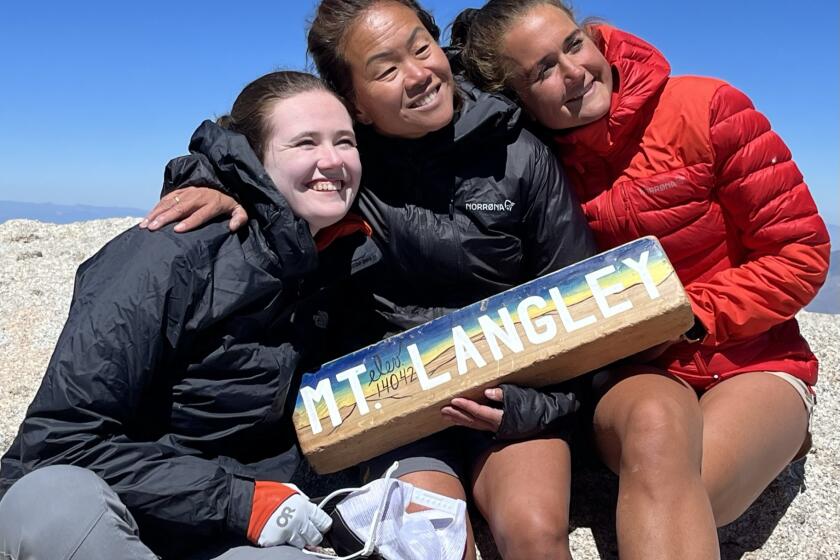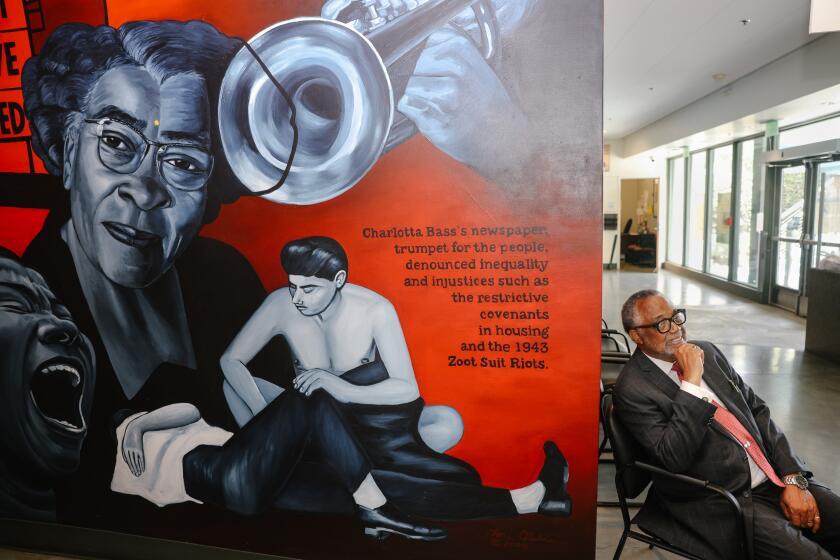Barry sobbed as he begged me not to fire him. I canned him anyway, over and over
Barry shifted uncomfortably in his seat. He didn’t know why I’d called him into my office, but he knew it couldn’t be good.
I told him we had gotten another report of inappropriate behavior — his sixth this year.
“Oh come on, everyone is so sensitive,” he said. “You know, it wasn’t like this 10 years ago.”
Barry was in his 60s. Finding another job to fill the years before retirement wouldn’t be easy.
“It doesn’t seem like it now, but this may be a good thing for you,” I said.
Comforting lies were not the move. Barry buried his face in his hands, sobbing. Then everything went black.
I took off the virtual reality headset, and the real-life offices of the Culver City VR studio Talespin, the architects of Barry’s very bad day, came back into focus around me.
I had failed the termination simulation.
Kyle Jackson, Talespin’s chief executive, started the company in the thick of 2015’s VR hype cycle, back when Facebook had just paid $3 billion for the scrappy headset maker Oculus VR, and Time and Vanity Fair devoted splashy cover stories to the technology that was “about to change the world.”
What you’re seeing today is not an evolution but a return to the application that’s always worked.
— Jeremy Bailenson, director of Stanford’s Virtual Human Interaction Lab
Today, the dream of goggle-wearing masses has deflated, and investment in the tech has dwindled. But VR companies like Talespin have found a growing market in simulating the least entertaining content imaginable: our jobs. Consumers may not yet feel the pull of visiting fantasy worlds in their free time, but for businesses that need to train their workers, better tools are a necessity, not a luxury.
“What you’re seeing today is not an evolution but a return to the application that’s always worked,” said Jeremy Bailenson, the director of Stanford’s Virtual Human Interaction Lab and one of the founders of Strivr, a competing virtual reality training start-up. He traces the roots of virtual reality back to the Link trainer, a mock airplane fuselage mounted on a platform that could simulate real flying sensations, which half a million military pilots used to safely train during World War II.
Talespin found its first major client in Farmers Insurance Group, which needed a new way to train claims adjusters for home inspections. The start-up designed a virtual house, complete with cluttered closets and leaky sinks, that trainees could scour for evidence of water damage. The simulation changed slightly each time, letting new hires rack up months’ worth of experience in just a few days.
The company has grown to 75 employees to match the demand for VR training coming from Farmers and other large corporate clients, fueled only by $5.6 million in outside investment. But the company always uses Barry’s termination as a demo for new clients — it’s a compelling proof-of-concept experience designed, Jackson said, “to see if talking to a virtual human can actually make you uncomfortable. It’s proved to be pretty effective.”
That emotional realism is what separates virtual reality from all the other tools for teaching interpersonal skills in the workplace, from pamphlets and role-playing workshops to interactive tutorials. The visuals that trick the brain into feeling like you’ve been transported to another space, the speech recognition software that allows you to speak and be understood, and the compelling character design of Barry himself (many of the company’s employees have past experience in video game design) all make for a more visceral experience than watching a video on a computer screen.
In his work in the lab and with Strivr, which started making VR training modules for professional athletes before moving to corporate clients such as Walmart and Verizon, Bailenson has seen how the psychological realism makes VR more memorable than other training methods.
I felt a flush of genuine shame seeing Barry’s lined face fall as he absorbed the fact that he was being fired. I’ve been on his side of the table, but never had to swing the ax myself. Apparently, my attempt to console Barry — picked from a multiple-choice menu of dialogue options, which I then said out loud — triggered the head-in-hands failure.
A prompt informed me that staying firm and focusing on the future was a better tack.
The solitude of virtual training also makes it more effective than real-life role-playing, according to its proponents. In a group setting, the fear of public failure and the natural tendency to avoid awkwardness can discourage or inhibit learning.
Behind the goggles, I could run the program as many times as I liked, trying different approaches without boring my virtual partner or worrying that I was too harsh, or slow, or timid.
I relaunched the module and saw Barry’s uncertain face come into view. This time, after some opening small talk, I decided to keep a firm hand.
“Your employment’s been terminated, effective immediately.”
Barry did not like that.
“I have 20 more years’ experience than anyone in there! Have you looked at my sales numbers?”
This isn’t about your job performance, I told him, trying to stay calm. When he didn’t back down, I tried calling him out. “This is the exact disrespectful attitude that got you here.”
He went for self-pity. “All I wanted was the best for this company,” Barry said. “You know, this is it for me. I won’t be able to work anywhere else.”
I saw another opportunity to soften things a bit. “You have a ton of experience, and plenty of time left to make your mark.”
Bad call. Barry flipped out, pounded on the table, and started yelling. “Who do you think you are? What are you, 30 years old? I’ve been doing this for 30 years, damn it!”
Another fail. This time, the screen advised me to “be careful with comments that can be misconstrued as ageism.”
I was rattled. But I felt like I was starting to get the hang of firing Barry. (Also, I am, in fact, 30, but we didn’t go there.)
Column One
Column One is a showcase for compelling storytelling from the Los Angeles Times.
Early VR boosters often touted it as a tool for building empathy, allowing people to inhabit the experience of others rather than merely read or hear about them. Innovators in the genre such as Nonny de la Pena and Janicza Bravo made experiences that put the user in the middle of a bombing raid in war-torn Damascus, or alongside an unarmed black man killed by the police.
Talespin and its competitors turn that idea on its head. By letting you experience the pain of others over and over again, they train you to shrug it off. After confronting a thorny HR problem like Barry in the safety of the goggles, I could more effectively stick to the script in real life.
Given how real Barry’s shock and sadness felt, I asked Jackson if he was based on an actual ex-employee. Had he fired a Barry for real?
“Oh, no, I’ve just fired this Barry about 3,000 times,” he said.
But his ultimate goal is to serve not only corporate clients, but also workers: through the power of VR, he hopes to improve their odds of surviving a downsizing.
Economists predict that increasingly advanced artificial intelligence and robotics will fundamentally change the labor market. Whereas past waves of automation have hit blue-collar jobs the hardest, this change is likely to stab at the soft belly of the white-collar workforce. A landmark 2013 study out of Oxford University found that workers such as paralegals, accountants, loan officers and data enterers are at the highest risk of being replaced by computers. A more recent report from the intergovernmental Organisation for Economic Co-operation and Development predicts that the U.S. is likely to lose 13 million such jobs to increased automation in the near future.
Jackson believes that Talespin’s technology can help workers deal with the constant job churn that may become the norm.
Besides Barry, the company has built a number of custom training scenarios that bring users face to face with virtual humans. There’s a simulation for making a hard sell, which prompts trainees to accomplish a certain goal, rather than providing multiple-choice options as in the Barry training, and uses speech recognition software to track whether they’re hitting the right notes to seal the deal.
Farmers has commissioned a training tool that lets employees practice building rapport with outside vendors. And another module, which will let the trainee practice intervening when a co-worker on a virtual hiring panel starts showing bias against certain job candidates, is in the works.
Down the line, Jackson hopes that Talespin might be able to partner with schools and state regulatory bodies, with an accreditation program that job seekers could list on their resumes.
And with 13 million people forecast to get laid off in the coming years, being Barry-certified could carry some weight in the hiring process.
With an eye toward my continued employability, I relaunched the simulation. Barry’s lined face and disarmingly moist eyes once again faced me across the table.
This time, I tried to pick the prompts that read like corporate boilerplate — polite, optimistic and ultimately unsympathetic.
First the small talk, then I told Barry he had said one too many inappropriate things.
He dug in deeper. “This is about what happened with Kaitlin, isn’t it? In my opinion, what she was wearing was inappropriate in a meeting with a client. All I did was point that out.”
Be the robot, I thought. “Policy is policy, and you’ve crossed a line.”
Barry again veered into self-pity, saying he’d never work again. Time for some meaningless pluck.
“I’m confident in you and your ability to find something that works for you.”
Faced with my wall of platitudes, he accepted his fate.
“Well, I didn’t see this coming,” Barry said. “I really thought I was going to finish my career here. I had so much more to accomplish.” He sighed and said it had been a pleasure working with me.
He held a sad half-smile, the smile of a powerless man, as the simulation froze.
More to Read
Inside the business of entertainment
The Wide Shot brings you news, analysis and insights on everything from streaming wars to production — and what it all means for the future.
You may occasionally receive promotional content from the Los Angeles Times.













